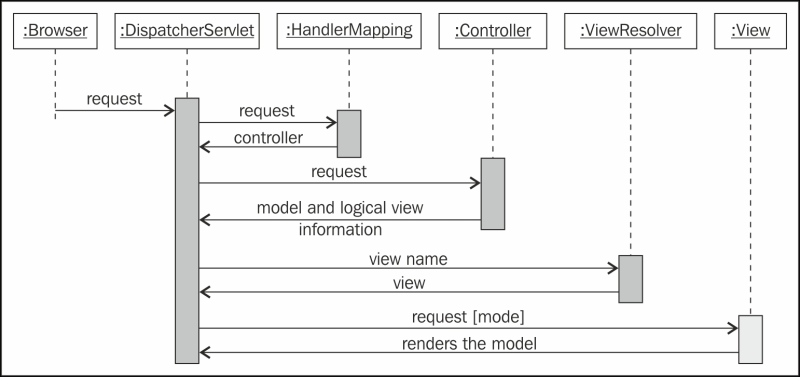In Spring MVC, the following is a pattern of a simplified request handling mechanism:
DispatcherServletreceives a request and confers the request with handler mappings to find out which controller can handle the request, and then passes the request to that controller.- The controller performs the business logic (can delegate the request to a service or business logic processor) and returns some information back to
DispatcherServletfor user display or response. Instead of sending the information (model) directly to the user, the controller returns a view name that can render the model. DispatcherServletthen resolves the physical view from the view name and passes the model object to the view. This way,DispatcherServletis decoupled from the view implementation.- The view renders the model. A view could be a JSP page, a servlet, a PDF file, an excel report, or any presentable component.
The following sequence diagram represents the flow and interaction of Spring MVC components:

We will build a Spring web application and unit test the code using JUnit. The following are the steps to be performed:
- Launch Eclipse and create a dynamic web project named
SpringMvcTest. - Open
web.xmland enter the following lines:<display-name>SpringMVCTest</display-name> <servlet> <servlet-name>dispatcher</servlet-name> <servlet-class> org.springframework.web.servlet.DispatcherServlet </servlet-class> <load-on-startup>1</load-on-startup> </servlet> <servlet-mapping> <servlet-name>dispatcher</servlet-name> <url-pattern>/</url-pattern> </servlet-mapping> <context-param> <param-name>contextConfigLocation</param-name> <param-value> /WEB-INF/dispatcher-servlet.xml </param-value> </context-param> </web-app>The dispatcher is named
DispatcherServlet, and it maps all requests. Note thecontextConfigLocationparameter. This indicates that the Spring beans are defined in/WEB-INF/dispatcher-servlet.xml. - Create an XML file named
dispatcher-servlet.xmlinWEB-INFand add the following lines:<?xml version="1.0" encoding="UTF-8"?> <beans xmlns="http://www.springframework.org/schema/beans" xmlns:context="http://www.springframework.org/schema/context" xmlns:xsi="http://www.w3.org/2001/XMLSchema-instance" xsi:schemaLocation=" http://www.springframework.org/schema/beans http://www.springframework.org/schema/beans/spring-beans-3.0.xsd http://www.springframework.org/schema/context http://www.springframework.org/schema/context/spring-context-3.0.xsd"> <context:component-scan base-package="com.packt" /> <bean class= "org.springframework.web.servlet.view. InternalResourceViewResolver"> <property name="prefix"> <value>/WEB-INF/pages/</value> </property> <property name="suffix"> <value>.jsp</value> </property> </bean> </beans>This XML defines a Spring view resolver. Any view will be found under the
/WEB-INF/pageslocation with the.jspsuffix, and all beans are configured under thecom.packtpackage with Spring annotations. - Create a class named
LoginInfoin thecom.packt.modelpackage. This class represents the login information. Add two privateStringfields,userIdandpassword, and generate the getters and setters. - Create a JSP page named
login.jspunder/WEB-INF/view, and add the following lines to create a form using the Spring tag library. Modify the form and add normal HTML input for username and password:<%@ taglib prefix="sf" uri="http://www.springframework.org/tags/form"%> <sf:form method="POST" modelAttribute="loginInfo" action="/onLogin"> </sf:form>
- Create a controller class named
com.packt.controller.LoginControllerto handle login requests. Add the following lines:@Controller @Scope("session") public class LoginController implements Serializable { @RequestMapping({ "/", "/login" }) public String onStartUp(ModelMap model) { model.addAttribute("loginInfo", new LoginInfo()); return "login"; } }The
@Controllerannotation indicates that the class is a Spring MVC controller class. Insmapl-servlet.xml, we defined<context:component-scan base-package="com.packt" />, so Spring will scan this@Controllerannotation and create a bean. The@RequestMappingannotation maps any request with the default path/SpringMvcTest/or/SpringMvcTest/loginto theonStartUpmethod. This method returns a logical view namelogin. The view resolver defined in the XML file will map the login request to the physical viewlogin.jsppage under/WEB-INF/pages. - Create another method in the
Loginclass to handle the login and submit requests, as follows:@RequestMapping({ "/onLogin" }) public String onLogin(@ModelAttribute("loginInfo") LoginInfo loginInfo, ModelMap model) { if(!"junit".equals(loginInfo.getUserId())) { model.addAttribute("error", "invalid login name"); return "login"; } if(!"password".equals(loginInfo.getPassword())) { model.addAttribute("error", "invalid password"); return "login"; } model.addAttribute("name", "junit reader!"); return "greetings"; }The
onLoginmethod is mapped with/onLogin. The@ModelAttribute("loginInfo")method is the model submitted from thelogin.jspform. This method checks whether the username isjunitand password ispassword. If the user ID or password does not match, then an error message is shown on the login page, otherwise, thegreetingsview is opened. - Change the content of the
login.jspfile to submit the form to/SpringMvcTest/onLoginand themodelattributename tologinInfo, as follows:<sf:form method="POST" modelAttribute="loginInfo" action="/SpringMvcTest/onLogin">
Also, add the
<h1>${error}</h1>JSTL expression to display the error message. - Create a JSP file named
greetings.jspand add the following lines:<h1>Hello :${name}</h1> - In the browser, enter
http://localhost:8080/SpringMvcTest/; this will open the login page. On the login page, do not enter any value and just click on Submit. It will show the invalid login name error message. Now, enterjunitin the User Id field andpasswordin the Password field and hit Enter. The application will greet you with the message shown in the following screenshot:
We can unit test the controller class. The following are the steps:
- Create a
LoginControllerTest.javaclass incom.packt.controller. - Using the following code, add a test to check that when the user ID is null, the error message is thrown:
public class LoginControllerTest { LoginController controller = new LoginController(); @Test public void when_no_name_entered_shows_error_message(){ ModelMap model = new ModelMap(); String viewName = controller.onLogin(new LoginInfo(), model); assertEquals("login", viewName); assertEquals("invalid login name", model.get("error")); } } - Add another test to check invalid passwords, as follows:
@Test public void when_invalid_password_entered_shows_error_message() { ModelMap model = new ModelMap(); LoginInfo loginInfo = new LoginInfo(); loginInfo.setUserId("junit"); String viewName =controller.onLogin(loginInfo, model); assertEquals("login", viewName); assertEquals("invalid password", model.get("error")); } - Add a
happyPathtest, as follows:@Test public void happyPath(){ loginInfo.setUserId("junit"); loginInfo.setPassword("password"); String viewName =controller.onLogin(loginInfo, model); assertEquals("greetings", viewName); }
This is just an example of Spring MVC, so we checked the username and password with the hardcoded constants. In the real world, a service looks up the database for the user and returns an error message; the service can be autowired to the controller. This way, we can unit test the controller and the service layer.
